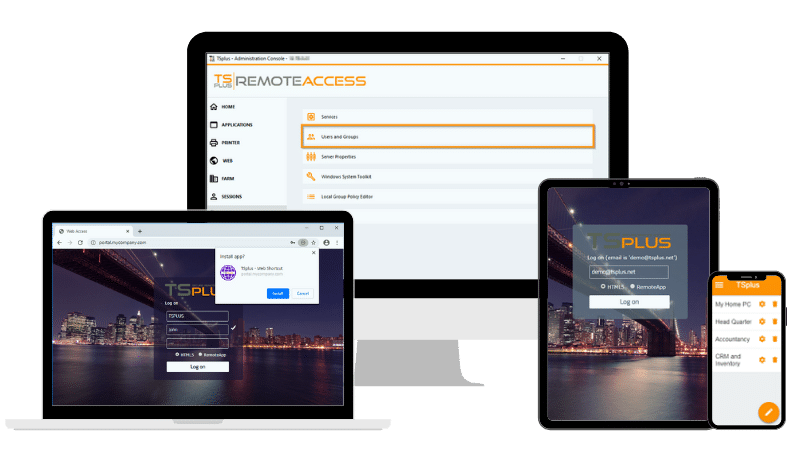)
)

TSplus Remote Access Free Trial
Ultimate Citrix/RDS alternative for desktop/app access. Secure, cost-effective, on-premises/cloud
Understanding Remote Desktop Protocol (RDP)
Windows RDP is a protocol developed by Microsoft, enabling remote connection and management of another computer. Embedded within the Windows operating system, RDP allows for a seamless remote desktop experience, making it a staple in many IT environments.
Multiple Concurrent Sessions
RDP supports multiple concurrent connections, allowing several users to work on a single remote system simultaneously. This feature is crucial for collaborative environments where team members need to access the same system without interrupting each other's sessions.
Clipboard Sharing and Printer Redirection
RDP facilitates clipboard sharing, enabling users to copy text, images, or files from their local computer to the remote desktop, and vice versa. Printer redirection is another pivotal feature, allowing documents opened on the remote desktop to be printed on a local printer, streamlining workflows significantly.
File Transfer Capabilities
With RDP, file transfers between the local and remote computers are possible, although this might require setting up shared folders or utilizing the clipboard for smaller files. This capability is essential for IT professionals who need to deploy software, updates, or transfer data between systems.
Security Measures
RDP employs Network Level Authentication (NLA), TLS/SSL encryption for data transmission, and can be further secured by limiting access through firewalls and using VPNs. However, RDP's security depends heavily on proper configuration and adherence to best practices.
Delving into TeamViewer
TeamViewer is a proprietary software solution that goes beyond simple remote desktop access , offering a suite of features designed for online collaboration, support, and management of remote systems across various platforms.
Cross Platform Comptability
TeamViewer stands out for its cross-platform support, operating on Windows, macOS, Linux, iOS, and Android. This universal compatibility ensures IT professionals can provide support or access systems across different devices and operating systems.
File Transfer and Sharing
TeamViewer simplifies file transfers, allowing users to drag and drop files from their local computer to the remote system. This functionality is vital for IT support and maintenance tasks, such as updating software or transferring data between devices.
Online Meetings and Collaboration
Beyond remote access , TeamViewer incorporates features for online meetings, presentations, and team collaboration. These tools are invaluable for training, demonstrations, and working together on projects remotely.
Advanced Security Measures
TeamViewer prioritizes security with end-to-end AES 256-bit encryption, two-factor authentication, and the ability to set trusted devices. These measures provide robust protection against unauthorized access and data breaches.
After reviewing the global presentation of RDP and TeamViewer, an thorough analysis on Windows RDP vs TeamViewer is needed.
Windows RDP vs TeamViewer - Comparison
Operating System Comptability
Windows RDP
Deeply integrated into the Windows ecosystem, RDP provides a seamless and efficient remote desktop experience for Windows users. This native integration supports features like RemoteFX for virtual desktop infrastructure (VDI) environments. Doing this enhances graphical performance and supports 3D rendering, something particularly beneficial in resource-intensive applications.
However, RDP's functionality on non-Windows platforms, such as macOS or Linux, is facilitated through third-party clients, which may not offer the full suite of features available in the Windows version. This limitation can be a significant hindrance in mixed-OS environments, potentially complicating remote access processes and diminishing user experience.
TeamViewer
TeamViewer boasts extensive cross-platform support, enabling remote access and control across a variety of operating systems. This includes Windows, macOS, Linux, iOS, and Android. This universal compatibility ensures that IT professionals can manage or support devices across any operating system with a single tool, eliminating the need for multiple remote access solutions .
TeamViewer's cross-platform capability is particularly advantageous for organizations with a diverse array of devices and operating systems, offering a unified remote access and support experience.
Security Considerations
Windows RDP
RDP leverages Network Level Authentication (NLA) as its first line of defense, requiring users to authenticate before establishing a session. This reduces the risk of brute force attacks and unauthorized access. Additionally, RDP sessions are encrypted using either RSA security or AES encryption, depending on the version and configuration. However, the security of an RDP setup hinges significantly on the proper configuration of these features, including the use of strong passwords, restricting access via firewalls. Were possible, it also runs RDP over a VPN to encapsulate the traffic in an additional layer of encryption.
TeamViewer
TeamViewer takes a comprehensive approach to security, employing RSA 2048 public/private key exchange and AES (256-bit) session encryption to secure the data channel. This end-to-end encryption ensures that data remains confidential and tamper-proof from the user's device to the remote desktop. Moreover, TeamViewer's two-factor authentication adds an extra layer of security. It requires a second form of verification to prevent unauthorized access, even if passwords are compromised. The ability to whitelist devices for connection further enhances security, allowing only trusted devices to establish connections.
Cost and Licensing
Windows RDP is included with Windows Professional and Enterprise editions, making it an inherently cost-effective solution for businesses already operating within the Windows ecosystem. However, to utilize RDP in a scalable, multi-user environment, such as with Windows Server, additional licenses, known as Client Access Licenses (CALs), are required for each user or device connecting to the server. Doing that will potentially increase the overall cost.
TeamViewer offers a tiered licensing model, providing a free version for personal use and various paid subscriptions for professional and commercial use, scaling in features and capacity with each tier. This flexibility allows businesses to select a plan that best suits their size and usage needs. It can also become a significant expense for larger organizations or those requiring advanced features.
Ease of Use and User Interface
Windows RDP presents a straightforward, no-frills interface that mirrors the user's desktop environment. This makes it highly familiar to Windows users. Its integration into Windows allows for native performance and functionality, such as support for multiple monitors and local resource mapping (e.g., printers, drives). However, for non-technical users or those unfamiliar with Windows, RDP may present a steeper learning curve, especially regarding initial setup and configuration for secure access.
TeamViewer , designed with a focus on user-friendliness, features an intuitive interface that simplifies remote access for users of all technical levels. Its quick setup, coupled with features like unattended access, remote reboot in safe mode, and easy file transfer. This setup makes it highly accessible for technical support, collaboration, and remote management tasks across various platforms. The straightforward design and functionality facilitate adoption and usage, particularly in environments where non-technical users require remote support .
Windows RDP vs TeamViewer - Conclusion
The decision between Windows RDP and TeamViewer hinges on the specific needs, preferences, and operating environment of your organization. RDP offers a cost-effective, integrated solution for Windows-heavy environments, while TeamViewer's versatility, security, and collaboration tools make it suitable for a broader range of applications, especially in heterogeneous IT ecosystems.
For organizations looking for a solution that combines the advantages of both RDP and TeamViewer, TSplus offers a compelling alternative. With robust security features, cross-platform support, and an intuitive interface, TSplus provides a versatile and efficient remote access solution that meets the demands of modern IT infrastructures.
Explore how TSplus can enhance your remote access capabilities by visiting our website. Discover solutions tailored for tech-savvy IT professionals across diverse environments and download a free trial .

TSplus Remote Access Free Trial
Ultimate Citrix/RDS alternative for desktop/app access. Secure, cost-effective, on-premises/cloud














)
)
)